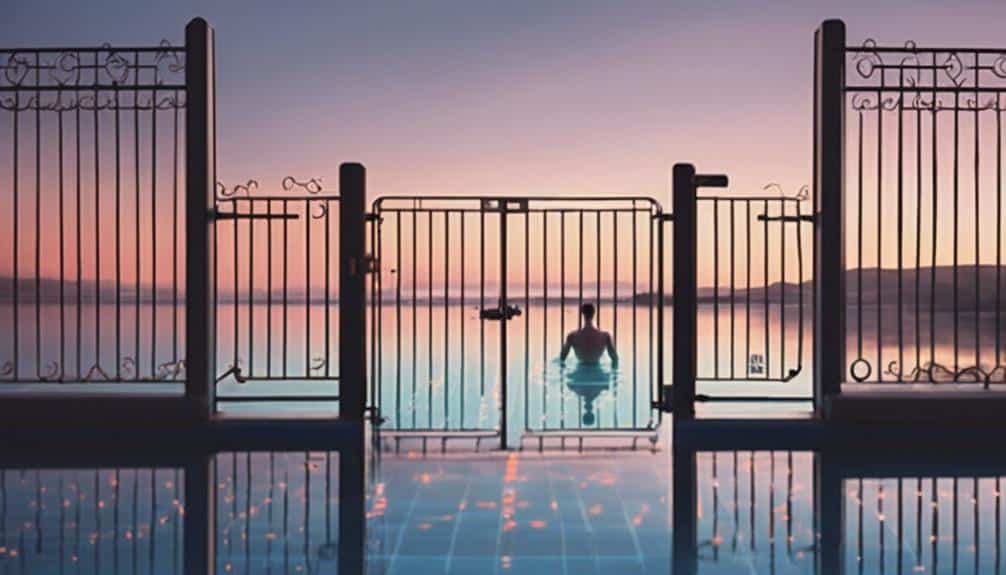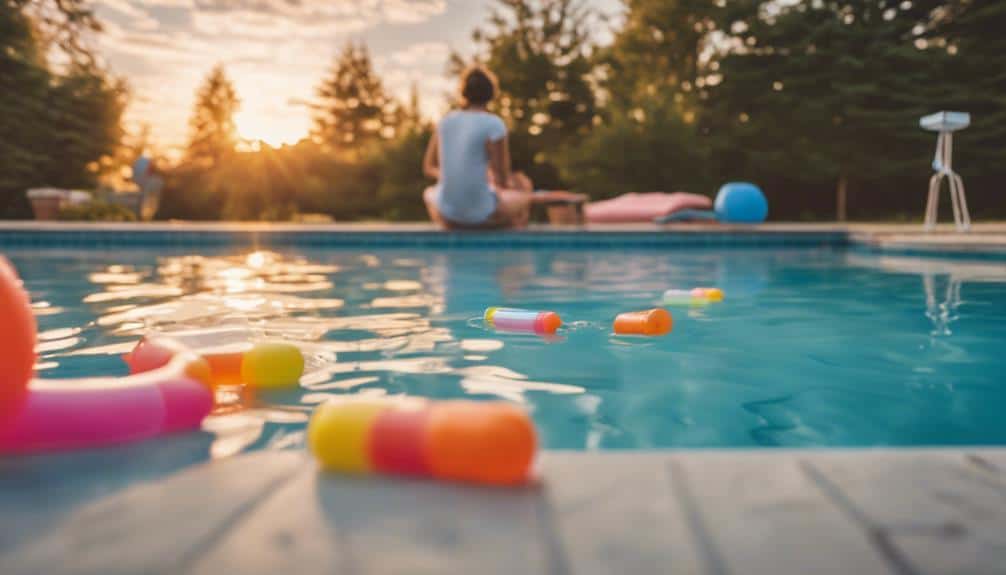After shocking your pool, you should wait at least 8 hours, and up to 24 hours in cases of superchlorination, before swimming to guarantee safe and healthy pool water conditions. This allows the chlorine levels to stabilize and the water chemistry to balance out. Test the chlorine and pH levels before swimming to avoid skin and eye irritation. Remember, it's essential to follow the manufacturer's instructions and take proper precautions to avoid health risks. By doing so, you'll be able to enjoy a safe and enjoyable swimming experience – and understanding the intricacies of shock treatment and chlorine levels will help you take your pool maintenance to the next level.
Key Takeaways
• Wait at least 8 hours after shocking a pool before swimming, and up to 24 hours for superchlorination.
• Testing chlorine and pH levels before swimming is crucial to avoid skin and eye irritation.
• Swimming too soon can cause serious health risks, including skin and eye irritation, and lung issues from chlorine exposure.
• Properly maintaining the pool's filtration system and showering before swimming helps maintain chemical balance and safety.
• It's recommended to consult a pool professional for personalized advice on safely balancing chlorine levels and pH levels for swimming.
Understanding Pool Shock Treatment
When you add a pool shock treatment to your pool water, you're effectively introducing a high dose of chlorine-based compounds to disinfect and sanitize the water. This chemistry-based process is vital in removing contaminants and irritants that can harm swimmers.
The chlorine-based shock treatment is designed to raise the free chlorine level in the pool, eliminating germs, viruses, algae, and bacteria that can compromise water quality.
As the shock treatment takes effect, it breaks down chloramines, which are irritating compounds that can cause eye and skin irritation. The quick-dissolving properties of pool shock make sure that the chlorine-based compounds are rapidly dispersed throughout the pool, providing a safe and clean environment for swimmers.
Regular pool shocking helps maintain the water quality and safety for swimmers, making it essential for pool maintenance.
Waiting Period for Safe Swimming

After you've added the shock treatment to your pool water, you'll need to wait a certain period before it's safe to dive back in, as the chlorine levels need to stabilize and dissipate to a safe range. Generally, it's recommended to wait at least 8 hours before swimming after shocking a pool. However, if you've performed a superchlorination or heavy shocking, you may need to wait up to 24 hours to make sure the chlorine levels have decreased to a safe range.
Before you can swim, it's important to test the chlorine and pH levels to make sure they're within the recommended ranges. Swimming too soon after shocking can lead to skin and eye irritation due to high chlorine levels. To avoid these issues, it's vital to follow the manufacturer's instructions and maintain proper filtration to guarantee safe swimming conditions.
Waiting the recommended time and testing the water conditions will ensure a safe and enjoyable swimming experience. Don't rush back into the pool too quickly, as the consequences can be unpleasant. Instead, be patient and prioritize your safety.
Risks of Early Swimming After Shock

Swimming too soon after shocking your pool can expose you to a multitude of health risks, including skin and eye irritation, altered water chemistry, and even lung issues from chlorine exposure. If you swim in a pool too soon after shocking, you may experience skin and eye irritation due to high chlorine levels. This can lead to uncomfortable and potentially painful reactions.
Additionally, early swimming can cause altered water chemistry, leading to potential health hazards. The chemistry of the pool water is sensitive, and shocking can disrupt this balance, making it unsafe for swimming.
Furthermore, lung issues may arise from chlorine exposure if you swim before the shock chemicals have dissipated. It's vital to wait until the chlorine levels have decreased to a safe range to avoid these health hazards. Superchlorination, a process that involves adding high levels of chlorine to the pool, may require an even longer waiting period before swimming to prevent health risks.
It's important to wait to swim until the pool is safe, as early swimming can have serious consequences. By waiting, you can guarantee a safe and enjoyable swim.
Precautions Before Entering the Pool

Before you enter the pool, you should take specific precautions to guarantee your safety and the pool's chemical balance, especially after shocking the pool. Wait at least 8 hours after shocking, and consider waiting up to 24 hours if you've performed Superchlorination. This allows the chlorine levels to stabilize, reducing the risk of skin and eye irritation, altered water chemistry, and potential health hazards.
Testing water is important before allowing swimming post-shocking. Use a chemical test kit or pool test kit to make sure the chlorine and pH levels are within the recommended range. This simple step can prevent a host of problems, from minor irritations to more severe health hazards.
In addition to waiting and testing, follow proper safety measures to ensure safe pool use. Maintain proper filtration, and shower before swimming to remove any contaminants or lotions that could affect the pool's chemical balance.
Is it Safe to Swim in a Pool After Shocking it for Safety?
After pool shocking and swimming safety regulations, it’s generally safe to swim in a pool. However, it’s recommended to wait until the chlorine levels return to normal. This usually takes about 24 hours. Be sure to always follow manufacturer’s instructions for pool shocking and maintain proper swimming safety practices.
Balancing Chlorine Levels Safely

By allowing 24 hours to pass after shocking, you can guarantee that chlorine levels stabilize and become safe for swimming. During this time, the shock chemicals dissipate, and the water's pH levels balance out, ensuring a safe and healthy swimming environment. It's important to wait 24 hours, as this allows the chlorine levels to stabilize between 1.0 and 4.0 parts per million (ppm), the ideal range for safe swimming.
Before taking the plunge, it's vital to test the pH levels to ensure water safety. This simple step can prevent eye and skin irritation, as well as damage to your pool's equipment and surfaces. If you're unsure about the safety of your pool water, consult with a pool professional for personalized advice tailored to your unique pool situation.
Frequently Asked Questions
Can I Swim 4 Hours After Shocking Pool?
If you're wondering if you can swim 4 hours after shocking your pool, the answer is no. Chlorine levels are still too high at this point, posing risks to your skin, eyes, and respiratory system.
You're better off waiting at least 8 hours to guarantee the chemicals have dissipated and the water is safe for swimming. Trust us, it's worth the wait – your health and safety are on the line.
What Happens if You Go in a Pool That Was Just Shocked?
Did you know that 75% of pool owners don't wait long enough after shocking their pool before swimming?
If you go in a pool that was just shocked, you're risking skin and eye irritation, respiratory issues, and even allergic reactions.
The high chlorine levels can cause discomfort and skin issues.
It's essential to wait until the chemicals have fully dissolved and the chlorine levels have dropped to a safe range before taking the plunge.
Is It Safe to Swim in a Cloudy Pool After Shocking?
When you're wondering if it's safe to swim in a cloudy pool after shocking, the answer is yes, as long as chlorine levels are back to normal. The cloudiness is likely due to dead algae or debris that'll be filtered out over time.
Verify that your pool's filtration and circulation systems are working properly, and the cloudiness should clear up within a day or two.
How Long Does It Take a Shocked Pool to Clear?
When the storm settles, you're excited to dive back in. But how long does it take a shocked pool to clear?
The waiting game begins. Factors like pool size, chemical levels, and shock type affect the timeline. On average, it takes 8-24 hours for the water to stabilize.
Be patient, and don't skip testing chlorine and pH levels before taking the plunge.
Proper filtration and circulation will get you swimming sooner.
Conclusion
As you dip your toes back into the pool, remember the shock treatment's lingering effects.
The waiting game's not over yet. Give chlorine levels time to balance, like a maestro conducting harmony.
Rushing in too soon can be a hazardous waltz. So, wait patiently, and let the chemicals do their dance.
Only then can you take the plunge, safe in the knowledge that your pool's waters are sanitized and ready for your splashy return.



